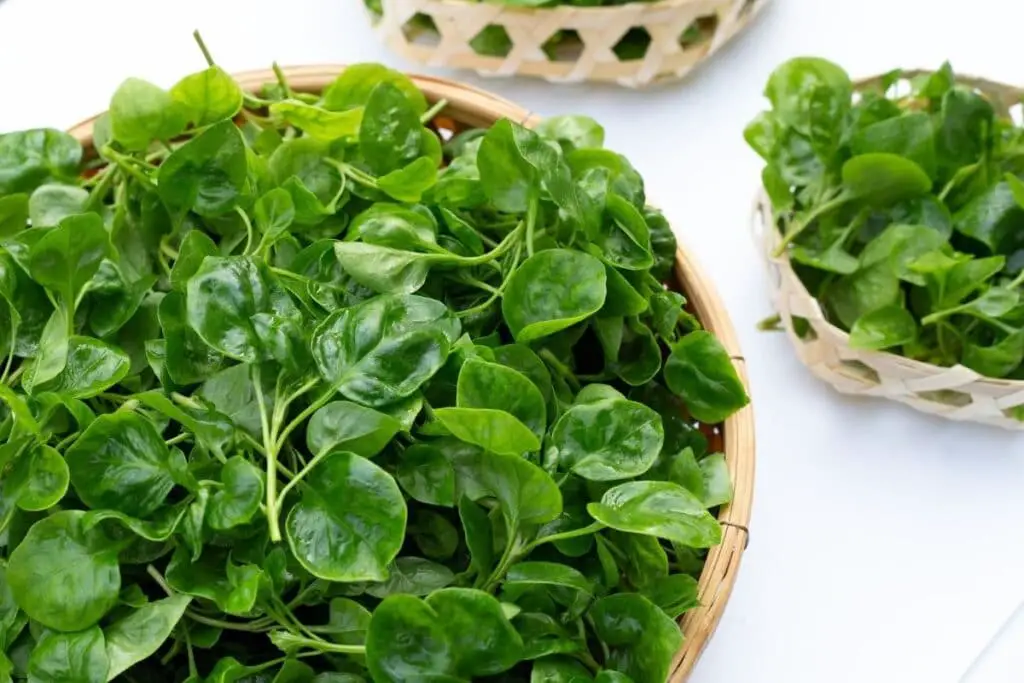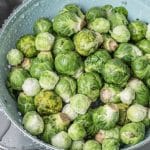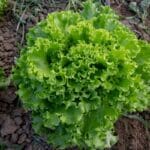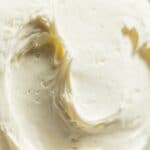In a nutshell: There are several substitutes for watercress, including arugula, dandelion greens, nasturtium leaves, upland cress, radish sprouts, etc. Each alternative is described along with its flavor and best uses, such as salads, sandwiches, and cooking.
Synonymous with English high tea, fresh watercress was popularly used in high tea sandwiches as part of an elaborate spread of pastries and savory treats. The delicious peppery green is now used largely as a healthy addition to soups, salads, potato dishes, and as a garnish.
Since it’s not always easy to find in stores, we’ve put together a guide for the best watercress substitutes when your recipe calls for these dainty greens but you just can’t get your hands on them. Here, you’ll also find out how to choose the most suitable alternative based on the type of recipe you are making.
What Is Watercress?
Watercress is a leafy green vegetable, often used fresh as a herb with its small rounded leaves. It is part of the same family as cabbage and grows in shallow streams where it floats on the water due to its hollow pale green stems. The entire plant is edible and offers a bright peppery taste. Very mature plants can have a somewhat bitter taste.
When watercress is cooked it loses some of its pungency and wilts as a result of its high water content. The greens are best stored in the refrigerator, covered. They don’t last very long so you might wonder if you can freeze them to prolong their shelf-life.
If you are planning to use your greens fresh in watercress salad or as a garnish, do not freeze them. If, however, you plan on cooking with the greens, you can freeze them since the wilted and mushy defrosted consistency will not be as noticeable when blended into soups or stews.
Best Watercress Substitutes
1. Rocket
Also known as arugula, arugula is one of the best substitutes for watercress since it is easily obtainable and shares the same peppery watercress taste.
Mature arugula leaves have a bolder flavor than the smaller, younger leaves. If you are growing your own greens you can control the flavor intensity by the growth stage at which you choose to pick and use them.
Store-bought leaves are generally quite mild. Rocket is a great option for pasta, salads, and soup. It also makes a great pizza topping. Although it is slightly less crunchy it stands up well to heat and doesn’t become as mushy as watercress when braised or added to hot dishes.
2. Dandelion Greens
Dandelion greens are a bit bitter with a peppery bite. As with arugula, the mature leaves have a more distinct flavor, so opt for the young leaves if you have a choice. Due to their bitterness, dandelion greens are not ideal used in salads but are best eaten cooked.
If you are using them as a fresh replacement you may have to adjust the quantity so as not to overpower the other flavors in your dish.
3. Nasturtium Leaves
Nasturtium leaves and flowers are probably more likely to be found in your garden than on grocery shelves. Unlike watercress, they are land shrubs and not semi-aquatic plants. You may not even have known that these round leaves accompanied by brightly colored flowers are an edible plant.
Sometimes referred to as Indian cress or monk’s cress, nasturtium leaves have a similar flavor to watercress which makes them an ideal substitute. The leaves vary in size and can be a lot bigger than watercress.
4. Upland Cress
Sometimes referred to as early yellow rocket, upland cress makes a great substitute for watercress with a similar flavor. However, it can have a slightly more intense bite.
Upland cress is great for maintaining a bit of crunch in a sandwich and can be used in cooked dishes without becoming too mushy. Give your batch a taste to determine whether you need to reduce the quantity slightly to avoid overpowering your dish with its peppery tang.
5. Radish Sprouts
When it comes to flavor, shape, and size, radish sprouts are the ideal alternative. The only problem is that they are not always that easy to find. You can easily grow them in small pots at home and pick them fresh for salads, sandwiches, garnishes, and to blend into pesto and dressings.
6. Purslane
Purslane is another ingredient that is more likely to be found growing in your garden or even driveway than in the grocery store. This little plant is often considered a weed but has great culinary potential.
Its red stems and small green leaves make great garnishes and additions to salads and sandwiches. It is also ideal for pesto and dips, soups, quiches, and smoothies. It has a somewhat sour-salty taste with a juicy and crisp texture due to its high water content.
Everyday Alternatives to Watercress
Since purslane, radish sprouts, and nasturtiums are not that easy to come across, you may need a substitution for watercress that is easier to find or already in your refrigerator. Use the following leafy vegetables when you’re in a pinch.
7. Baby Spinach
Baby spinach can be eaten raw or cooked. It is a lot softer and milder than regular spinach which makes it a great ingredient for salads. It also stands up well to heat. Thicker, bitter regular spinach leaves can also be used, however, they are not always loved in salads since they can be quite dense if not mixed with other greens.
Large spinach leaves are however great to cook with and are available year round. Both types of spinach can be used in smoothies, salads, stir-fry dishes, and quiche. If it’s the peppery taste you are after, crack some additional black pepper in with your spinach and you’ll have an easy watercress substitute without any hassle.
8. Kale
Kale is another green leafy vegetable that is fairly easy to find. Kale closely resembles spinach with a bitter flavor and dense leaves. Although it does not taste or look like watercress, if it’s all you have on hand it is ideal for cooking, stews, and smoothies. But, best leave this one out of the sandwiches.
9. Escarole and Belgian Endive
Both escarole and endives are part of the chicory family which indicates that they have a slightly bitter flavor profile. Escarole is the less bitter of the two greens but does not stand up to heat as well as endives.
If you like a punch of bitter greens and crunch in your salads, chop these and mix them in with slightly sweeter flavors for a delicious green salad mix. Alternatively, cook them with olive oil as a side dish or add them to stews and stir fry.
10. Radicchio
Radicchio brings a completely different color to your dish, so don’t think you’ll be fooling anyone with this substitute. The leaves do offer a great crunch, bitter, and slightly spicy flavor.
Chopped finely these dense white and purple leaves are great in salads. It is similar to cabbage when cooked, and takes to heat well, maintaining some texture.
FAQs
Conclusion
Watercress, also referred to as ‘cress’, is a nutritious leafy green that adds a great pop of peppery flavor to salads, sandwiches, pesto, soup, and potato salad. It can be used as a garnish for almost any savory dish.
The most similar substitutes for watercress aren’t always easy to find, but spinach, kale, and escarole are great pantry staples for substituting watercress.
Finer, more delicate greens are best for salads and garnishes while thicker options such as radicchio and kale are best cooked. The great thing, regardless of which alternative you choose, is that you’ll still be getting plenty of green nutritious goodness.
*image by Bowonpat/depositphotos









